Schneider-Kreuznach is active in the optics industry. We explain the basics of optics and our products to students and interested people with little previous knowledge.
Basics - OPTIcs
Aberrations
During the design and manufacture of a lens, unavoidable aberrations occur. In industrial image processing they are undesirable, in photography and film they are sometimes deliberately used. Typical aberrations include spherical and chromatic aberration, distortion, coma and astigmatism.
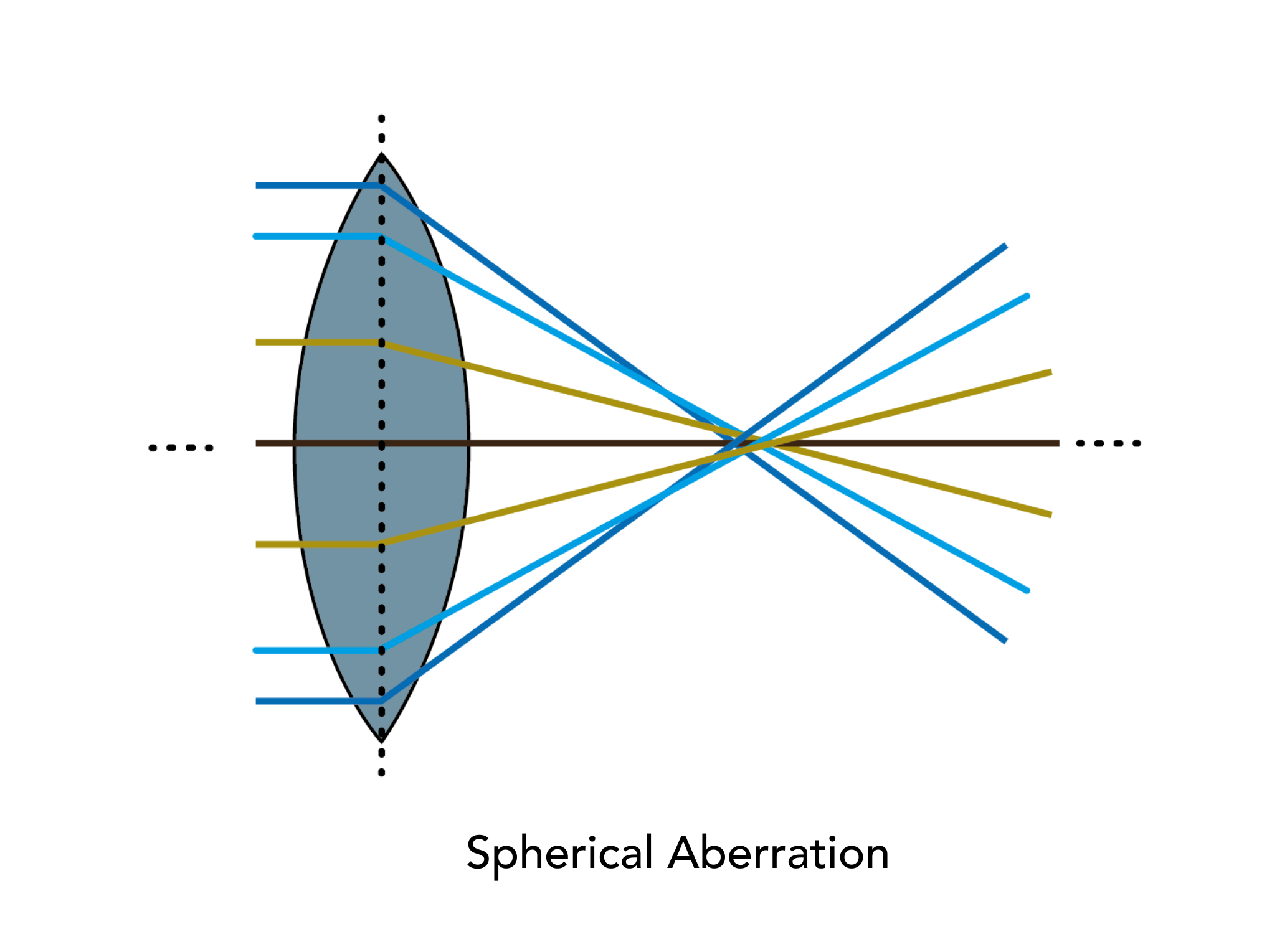 |
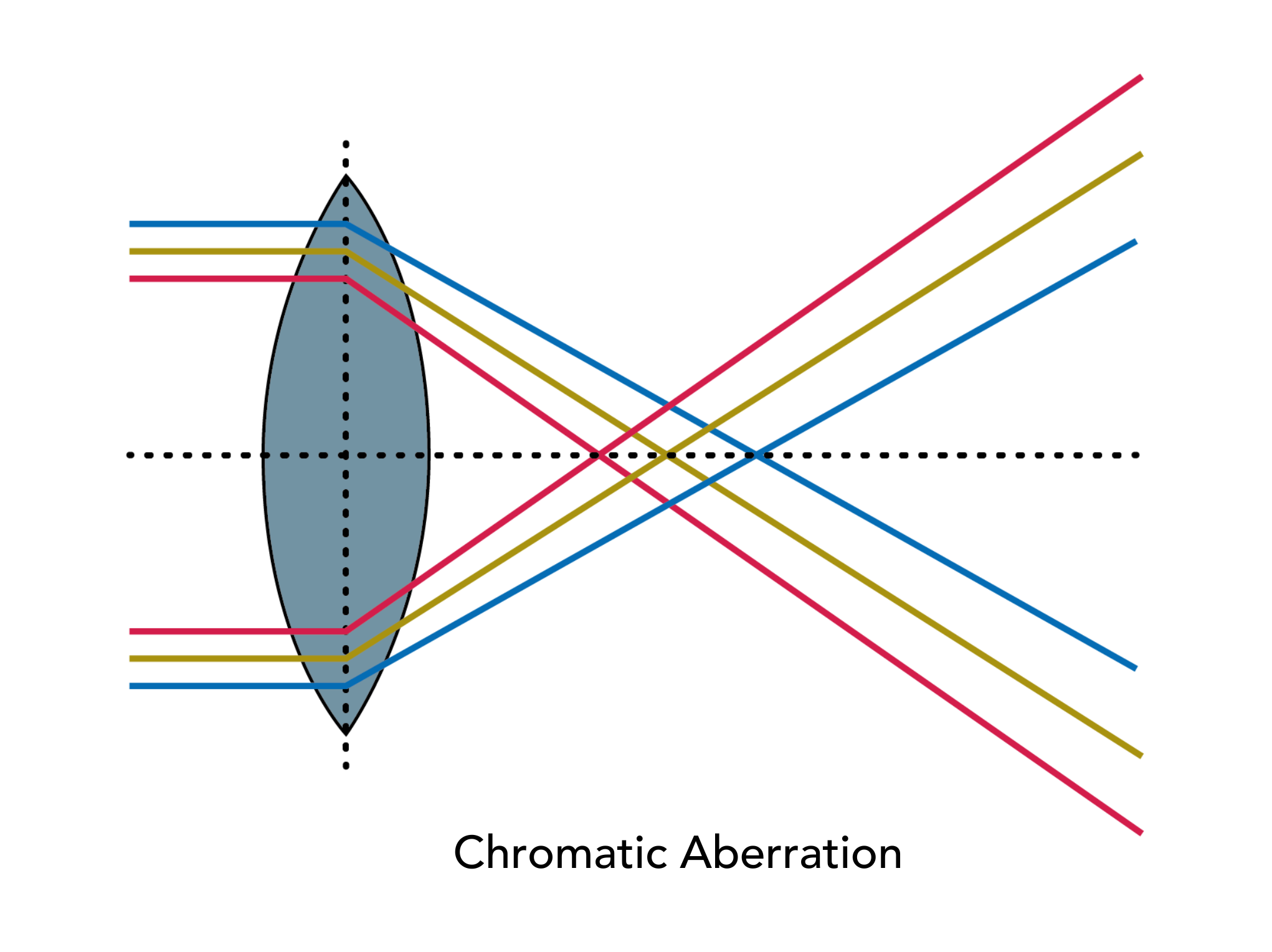 |
Spherical aberration (left) is an error that leads to loss of sharpness in the image. Light rays in the peripheral area of the lens are not imaged to the same point as rays through the centre of the lens. This results in a slightly blurred circular area rather than a single point in the image plane (sensor). Chromatic aberration (right) occurs when different wavelengths of light are refracted to different degrees. This becomes visible in the image, for example, as a coloured edge at the edges. |
|
Distortion is a geometric aberration that distorts the image. Straight lines are partly displayed in a curved way. The error is particularly visible at the edges of the image. Depending on the focal length and type of lens, the distortion is pincushion-shaped (left, especially with telephoto lenses) or barrel-shaped (right, especially with wide-angle lenses). The centre shows an image without distortion. Distortion can be easily corrected by image processing software. |
 |
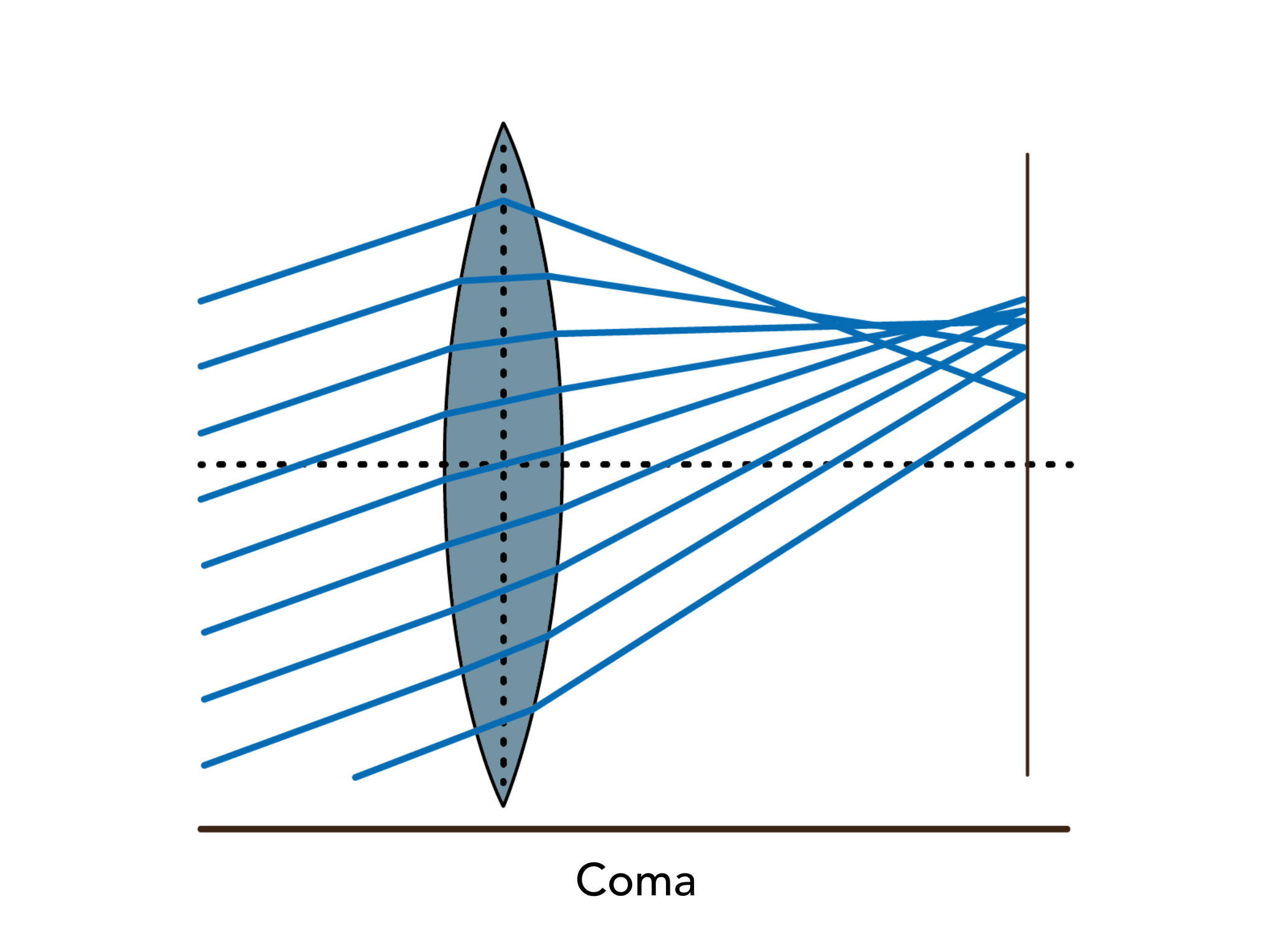 |
Coma is an asymmetry error in optics and occurs outside the optical axis in the image field when not all rays meet in the same point. In the image, coma often shows up as a tail or a drop-shaped image of a pixel.
|
Fields of application of optics
In physics, optics is the study of light. It deals with light sources and propagation, reflection and refraction of light. Optical images, the function of lenses, magnifying glasses and cameras as well as colours are also part of this field. At Schneider-Kreuznach, optics are manufactured in the fields of industrial image processing, photography and film.
In industrial image processing, the areas of application are diverse: from quality control in production to flashers in road traffic or as a partner to science: Schneider-Kreuznach has already cooperated with NASA several times, such as in 2021 on a rocket flight to the James Webb Space Telescope. In the photographic sector, Schneider-Kreuznach sells high-quality photo filters under the B+W brand. These can be used to create a specific atmosphere or to avoid unwanted effects such as reflections. With photo filters, a good result can be achieved right from the start without having to use an image editing programme later. This is because image information cannot be added later, because software is mainly suitable for retouching. In film, you want to convey emotion and mood. Diffusion filters such as the "Hollywood Black Magic" or the Radiant Soft give a soft shimmer, conceal skin blemishes and conjure up a beautiful image. The goal in film is a beautiful bokeh, i.e. a successful transition between sharp and blurred image areas. Our filters are used for shows or films: The True-Streak effect filter was used during the filming of The Weeknd's halftime show at the Super Bowl in 2021. The Radiant Soft filter was used in the shooting of the German series "PARA - Wir sind King".
Camera construction
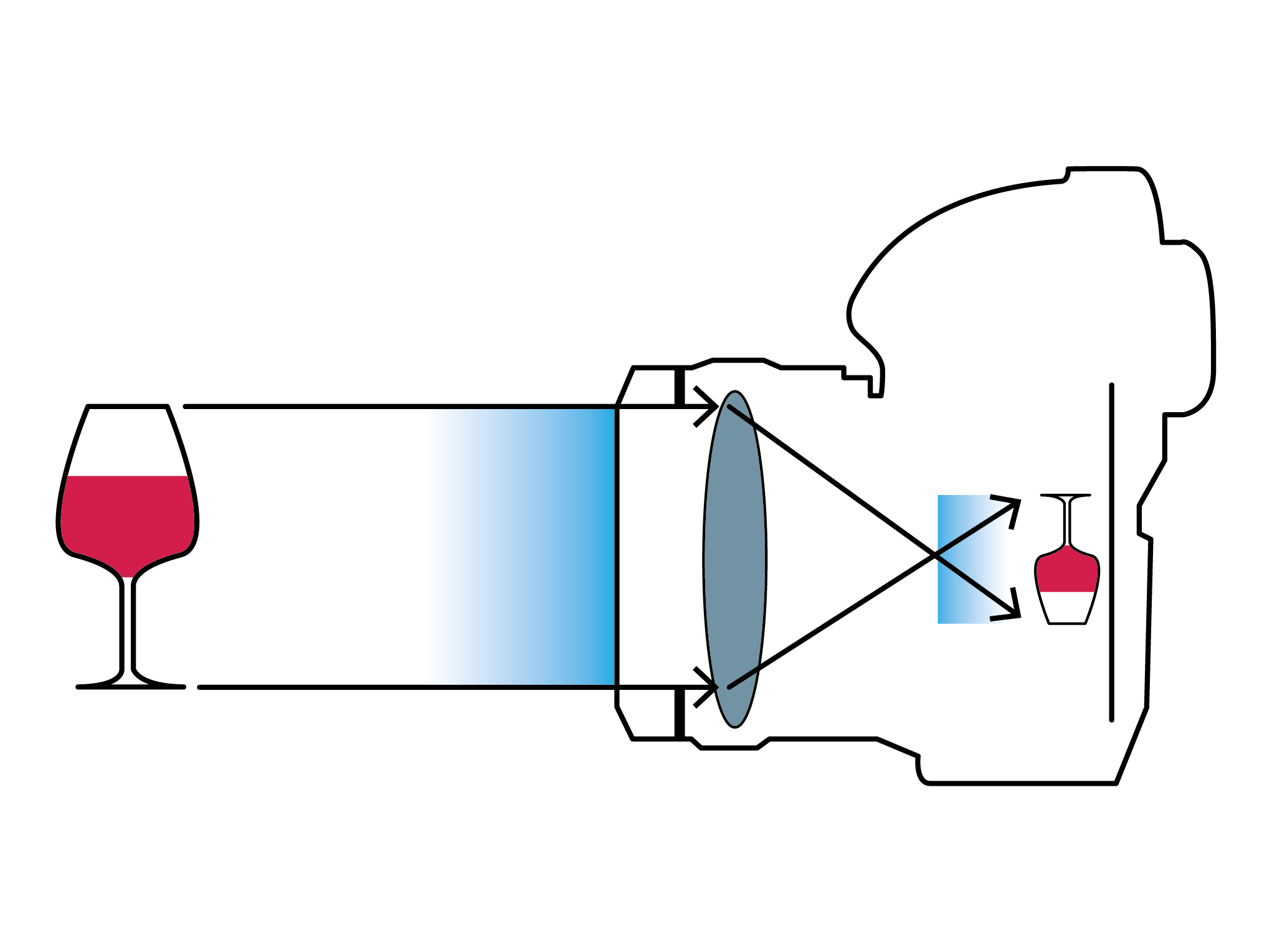 |
The simplest form of camera is a pinhole camera. It is a black box with a hole through which light falls onto the opposite side, creating an upside-down and side-inverted image. A modern camera is nothing different in principle. In place of the hole is the lens and where the image is formed is a light-sensitive sensor or film. If the lens is detachable, usually only the housing with the sensor and lens mount is called a camera. |
More information on this can be found in the Basics - Lenses.
Lens construction
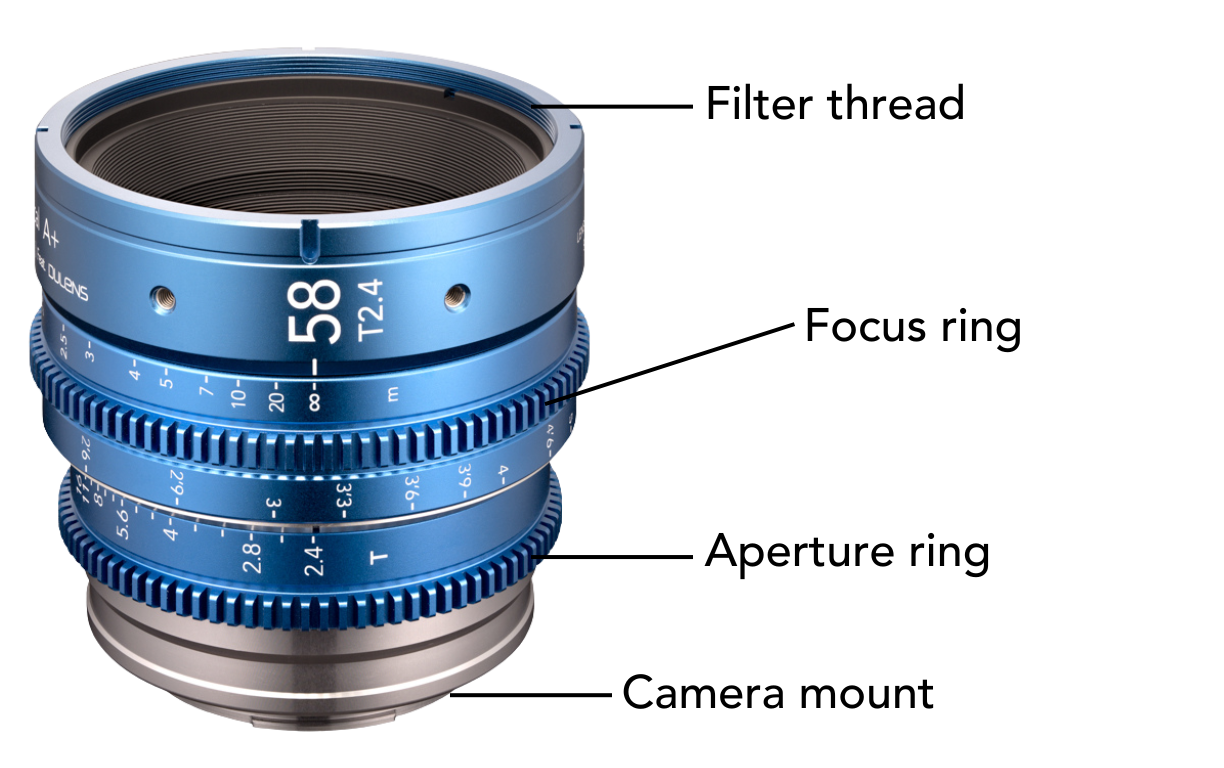 |
Lenses with a simple design basically consist of a black tube with several lenses and a mechanical diaphragm that can usually be adjusted. You can imagine a lens like a human eye with pupil and iris. By means of an optical image, the lens system of the lens reproduces a section of the environment in front of the lens on a sensor or film - comparable to the image in the eye on the retina.
|
Concave and convex lenses
Optical lenses have different shapes, functions and applications. The light is refracted at the air-glass transitions and changes its beam direction. In general, the more curved a lens is, the more light is refracted. Lens surfaces are usually convex (outwards, see illustration on the left) or concave (inwards, see illustration on the right). A typical biconvex converging lens has two outwardly curved surfaces and focuses the light. A typical biconcave diverging lens has two inwardly curved surfaces and diffuses the light.
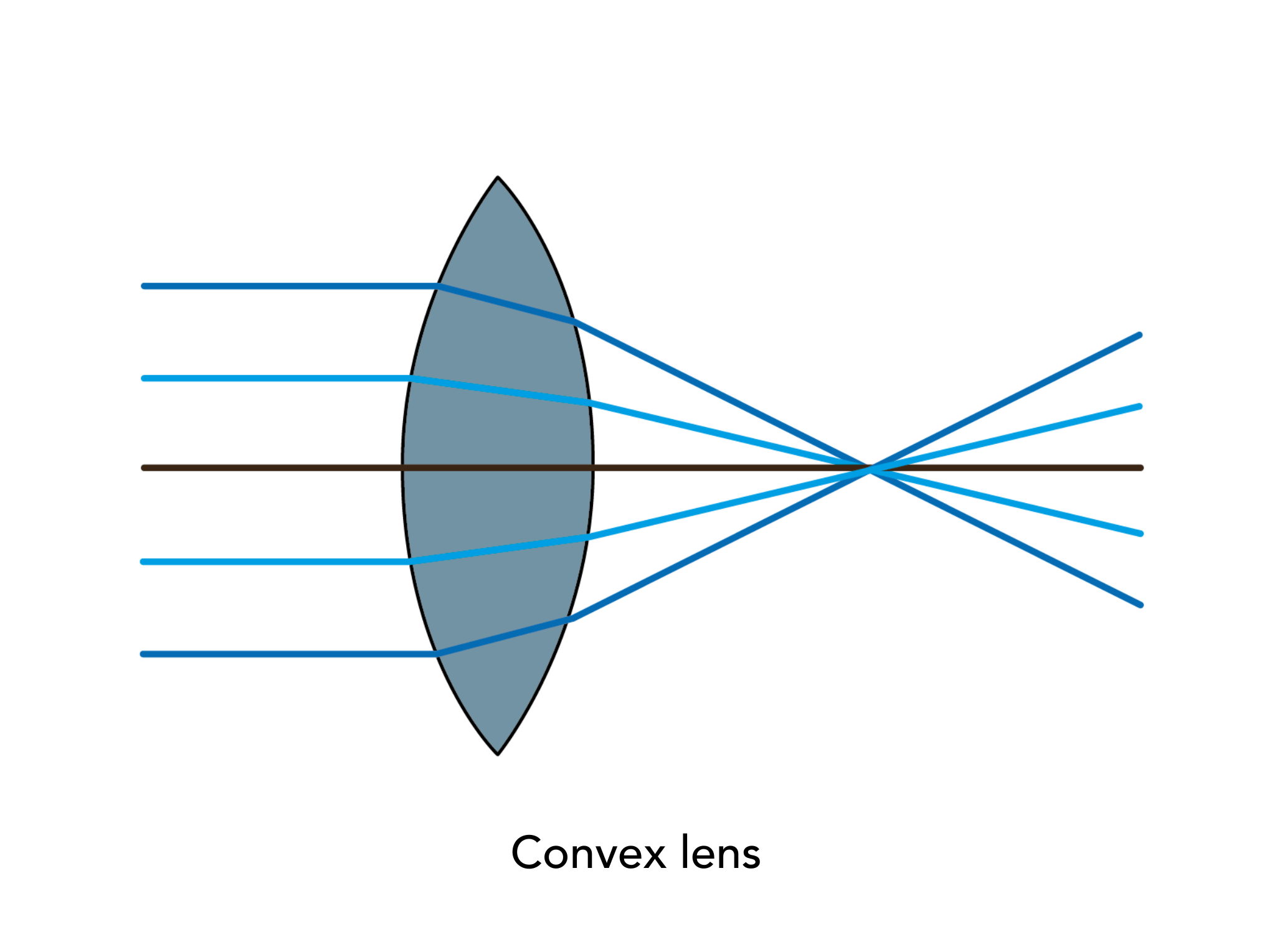
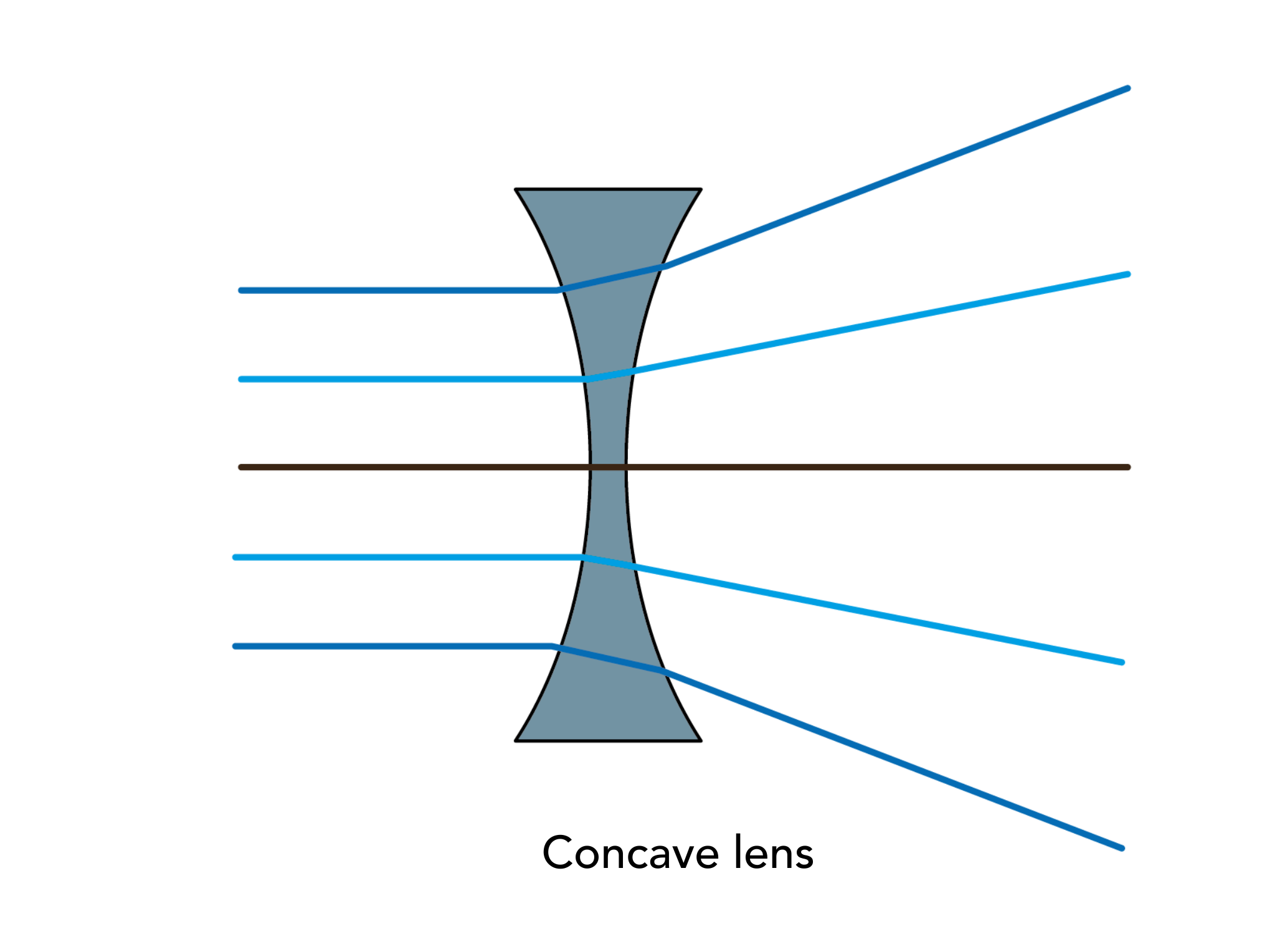
In lenses, a combination of different lens shapes is used to reduce aberrations as much as possible and thus achieve the sharpest and most contrasting image possible on the sensor.
Light and colour
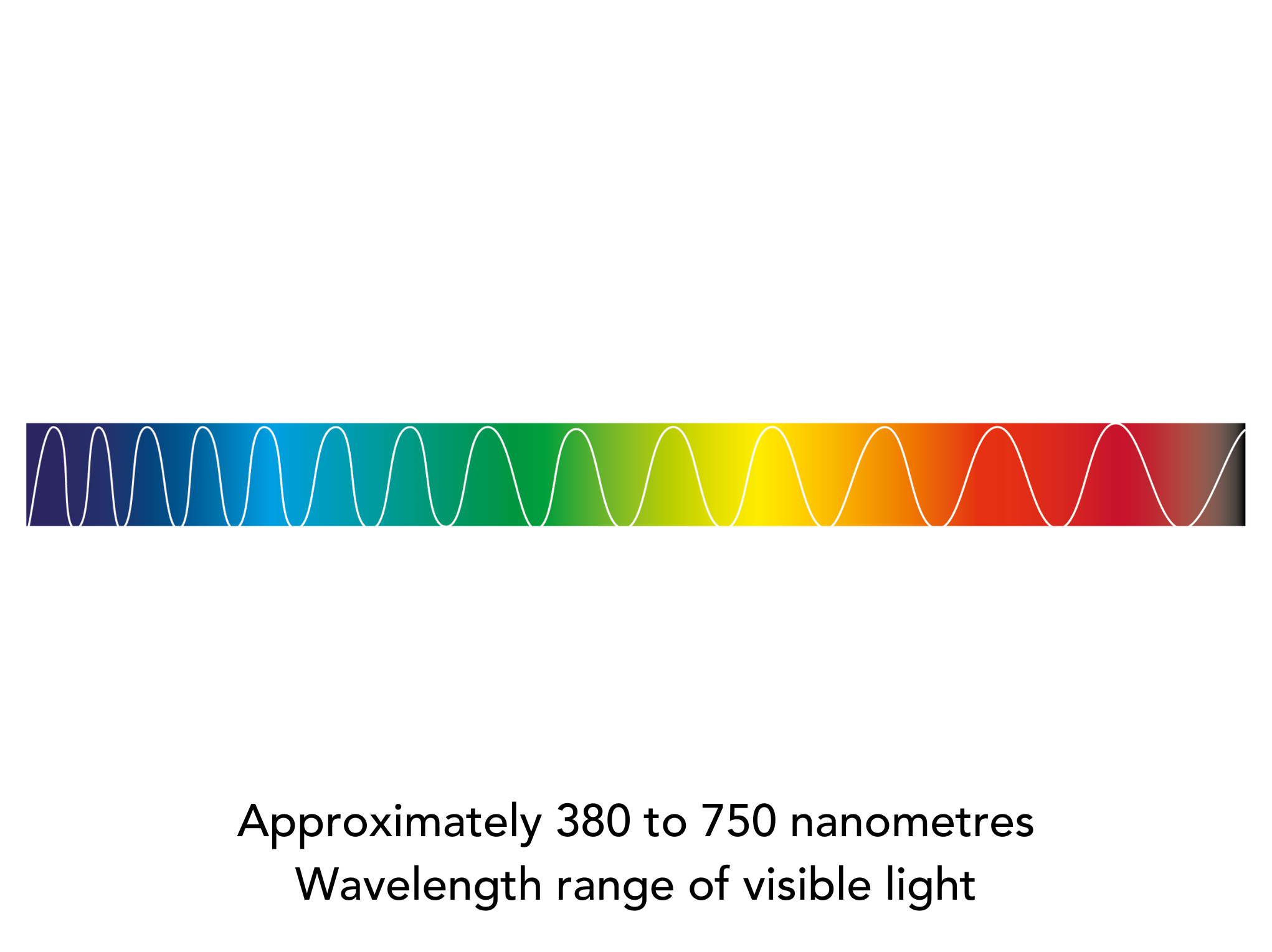 |
Light is a form of electromagnetic radiation whose properties can be described by various models. The wave model and the radiation model are often used.
|
In principle, light propagates in a straight line, which is why we also speak of light rays and represent them graphically as lines. Accordingly, the path of light through a lens is called a ray path. A multitude of light rays form a light bundle that usually spreads out conically from the light source. Light sources are divided into natural light sources, e.g. the sun, and artificial light sources, e.g. luminaires and flash units for illuminating objects in photography, videography and industrial image processing.
When objects are illuminated, part of the light is reflected and can be perceived by a camera or even the eye of a viewer. Depending on how much light and which colours are reflected, the object appears brighter or darker and also coloured accordingly. Light that is not reflected is either absorbed or transmitted. Black objects absorb the incoming light almost completely, while polished glass transmits the incoming light almost completely. Lenses, for example, are blackened on the inside as best as possible to minimise unwanted reflections from the mechanics. The lenses, on the other hand, are polished as best as possible and usually anti-reflective coated so that the light rays are disturbed as little as possible on their way through the lens to the sensor/film at the lens surfaces.
Production of optic lenses
In order to manufacture optical lenses, glass is first needed. This is produced by companies such as SCHOTT from various materials through a process of melting and cooling. Schneider-Kreuznach buys a wide range of glass types, as glass with different refractive properties is needed to manufacture a lens.
Individual lens blanks are cut out of the delivered glass blocks. These are then ground, polished, centred and tempered by precision opticians (m/f/d). During processing and after completion, the precision opticians use high-precision measuring instruments to measure whether the lens has the desired properties. It is a matter of thousandths of a millimetre. Once the lens is finished, trained industrial mechanics (m/f/d) assemble it together with mechanical components into a finished lens. Dust-free clean room conditions are important here.
The mechanical components are produced in advance in the assembly department by cutting machine operators (m/f/d), among others. Different trades have to work together before a finished lens can be made from a glass block and a metal tube.
Lens and filter coating
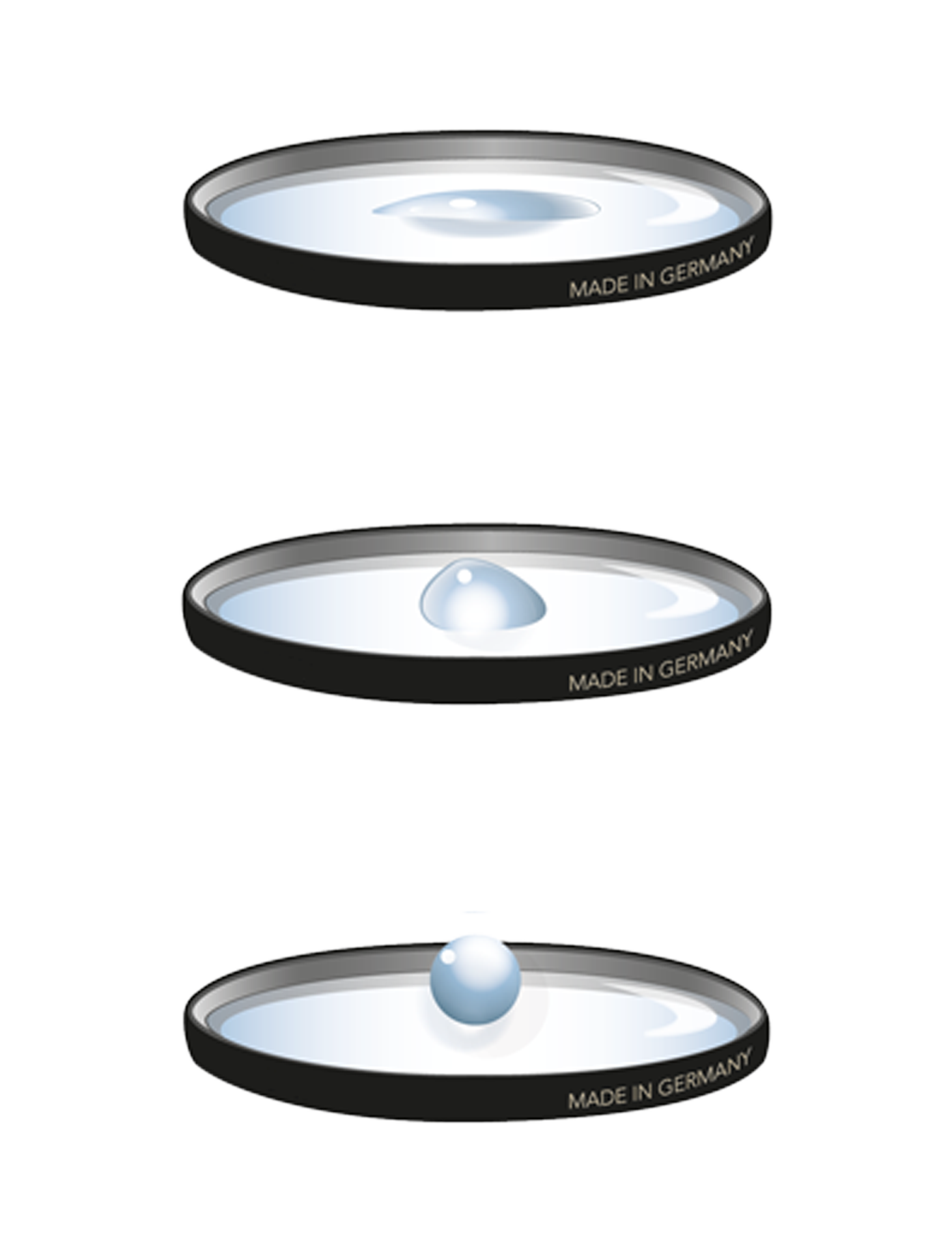 |
Lenses and filters can be coated by applying very thin layers. This reduces reflections and protects the surface from water, dust and fingerprints. In addition, coating makes it easier to clean the lenses and filters.
|
Basics - Lenses
Aperture
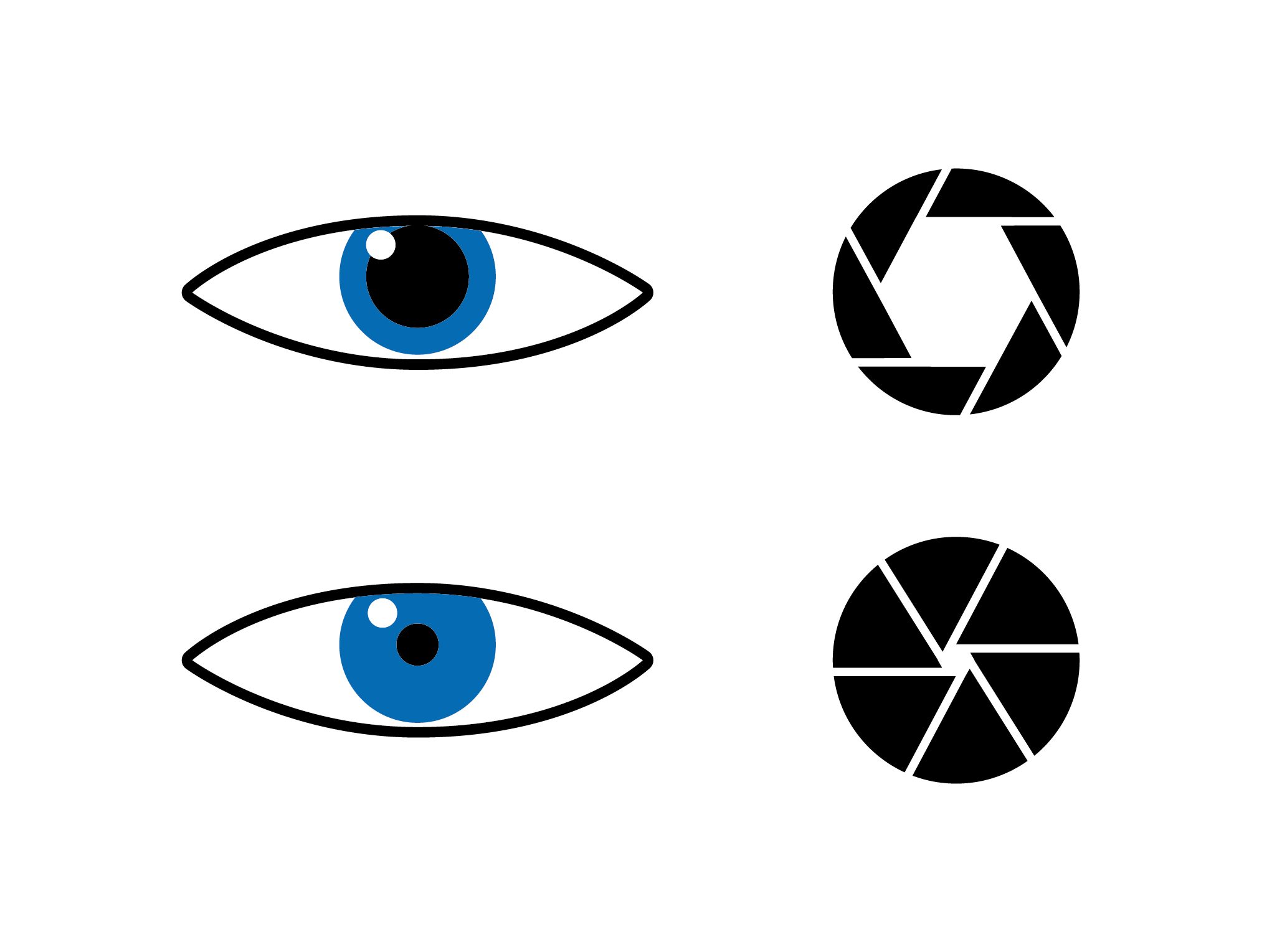 |
The aperture adjusts the amount of light that enters. In this way, it functions in a similar way to the pupil of the human eye: when there is a lot of light, the pupil becomes smaller so that you are not too dazzled. In low light, you have large pupils so that you can see as much as possible even in the dark. In a lens, the aperture is usually a round opening that can be adjusted mechanically. Again, small aperture means little light, large aperture means a lot of light. In addition to the light, the aperture also adjusts the depth of field, i.e. the area in front of and behind the set distance that is still perceived as sharp.
|
Focal length
The focal length affects the angle of view a lens will produce for a given sensor size. The shorter the focal length, the larger the angle of view of the lens (wide-angle lens). The longer the focal length, the smaller the angle of view of the lens (telephoto lens). We speak of a standard focal length when the focal length roughly corresponds to the sensor diagonal - below this is a wide-angle lens, above it a telephoto lens.
Standard lenses have a focal length that roughly corresponds to the sensor diagonal. In the 35 mm format, for example, the diagonal is 43.2 mm; accordingly, lenses with focal lengths of approx. 40-60mm are called standard lenses. The image impression created by standard lenses corresponds more or less to human visual habits. Lenses with a focal length significantly shorter than the sensor diagonal have a larger angle of view than standard lenses and are therefore called wide-angle lenses. In the 35mm range, these are usually focal lengths of 35mm and shorter. Wide-angle lenses are often used in landscape and architectural photography, where the effects of an accentuated foreground combined with a disproportionately reduced background can create a very interesting pictorial effect. Wide-angle lenses are also often a solution when a subject needs to be shot to fill the format from a relatively short distance. For the lens manufacturer, it is a great challenge with wide-angle lenses to reduce distortion and vignetting to such an extent that they are no longer perceived as disturbing in the images. In contrast to wide-angle lenses, the focal length of telephoto lenses is always greater than the sensor diagonal. This results in an angle of view that is significantly smaller than that of wide-angle and standard lenses. Telephoto lenses are often used where details of a larger scene need to be shown in full detail or where a greater shooting distance needs to be bridged. Typical examples are animal and sports photography, but also paparazzi often use telephoto lenses in order to be able to photograph unnoticed from a greater distance. Due to physical conditions, telephoto lenses usually have a relatively large front lens and are also usually significantly longer and heavier than standard and wide-angle lenses.
Filter thread
Many lenses have a filter thread at the front. A filter, but also other accessories such as a lens hood or a special filter holder, can be screwed in there. You can find more information on this in the explanations on filters.
Focus
In order to focus at a certain distance, individual or all lenses in the lens are moved. In terms of the human eye, the focus is the point that we see sharply. If we are too close or too far away from an object, we see it out of focus. Then the focus must be corrected.
Camera mount
The so-called camera mount is a thread or bayonet that connects the lens to the camera. This allows different lenses to be used on one camera.
Lenses I: Overview
Lenses can have different requirements: In film, we want to tell a story and depict moods; in industry, what counts is an image that is as sharp and detailed as possible. The same applies to our filters. Depending on the application of the lens, you have to pay attention to the following:
• At what distance does the lens need to focus?
• Do you want to focus on something in motion or at a standstill?
• Are certain wavelengths of light (for example long-wave IR radiation) of interest that are invisible to the human eye?
• How big does the lens have to be to be able to image my object?
• Do I want an image that is as sharp and detailed as possible or a beautiful bokeh (balanced transition between sharp and blurred areas of the image)?
For this reason, we explain separately the areas of application of industrial and film lenses.
Lenses II: Industry
Machine vision can be used for many things: Quality inspections in production, traffic monitoring, medical technology or in space travel. In many areas of life, optical systems are integrated into our everyday lives without us being aware of it. Due to the diverse applications, there are lenses with different properties in all kinds of sizes and shapes.
Schneider-Kreuznach also manufactures customised lenses if a standard lens cannot meet all requirements. The following standard lenses can be found in the Industry business unit:
• Lenses with fixed focal length, e.g. our OPAL industrial lens.
• Telecentric lenses, e.g. our SYLVINE lenses
• SWIR lenses, e.g. our industrial lenses CHAROITE, CUPRITE and CRYOLITE
• Lenses with extremely high light intensity, e.g. our industrial lens ONYX
• Lenses for long distances, e.g. our TOPAZ lenses
• For capturing the smallest details, e.g. our DIAMOND lenses
• Lenses for line sensor applications, e.g. our SAPPHIRE lenses
• Lenses with additional beam splitter, e.g. our ZIRCONIA lenses
Lenses III: Cine
With film, the shots are not viewed individually, but 25 frames/second. Our eye cannot capture every single frame, but perceives the movement with a certain amount of blurring. The requirements for cine lenses are therefore different from those for photo and industrial lenses. Besides a sharp motif, camera people are also interested in bokeh and flares. The out-of-focus areas and the sharpness gradient as well as the reflection of the highlights are crucial when choosing the right lens.
Typical of cine lenses is that they are usually offered in sets, consisting of several focal lengths of one series, they have the same colouring and the same image effects, this makes post-processing easier. Film lenses are easily recognisable by their long focus travel and gear rings for follow focus. It is also typical that the aperture and focus ring are in the same place for all focal lengths. This saves time and therefore money when shooting.
In contrast to other lenses, the aperture on film is given in T-stops, i.e. the amount of light that passes through the lens, and not in F-stops, the size of the aperture. In addition to the classic spherical (also called prime) lenses, there are also special lenses such as anamorphic lenses for widescreen photography. Schneider-Kreuznach ISC04all combine all of these. The set consists of 3 mini prime lenses the ISCOSpherical in the focal lengths 43, 58 and 85 mm for classical shooting or with the ISCORAMA attachment for anamorphic shooting.
Lenses IV: Special lens types
Anamorphic lenses allow widescreen images to be captured without the need for a widescreen sensor. They are often used in the film industry to create a "cinema effect" with a wide image. During shooting, the image is squeezed so that it can be completely imaged on the sensor. In post-production, the image is desqueezed to the original aspect ratio. Macro and micro lenses are special lenses optimised for capturing very small objects. In photography, they are often used for insect and flower photography. In industry, they are used where very small defects need to be found, such as in the automatic inspection of mobile phone and computer displays. And of course, microscope lenses are known from the medical field, where they are an important component of microscopes.
With shift lenses, the optical axis can be shifted in relation to the sensor. If you have ever photographed tall buildings with the camera tilted upwards when travelling, you know the plunging lines that make the building appear distorted. If you use a shift lens, on the other hand, you can photograph the tower or skyscraper with the camera pointed horizontally so that the lines are shown vertically on the image, which appears much more natural to the human eye. Mirror lenses are a special type of telephoto lens. In addition to lenses, at least 2 mirrors are built into them. This makes the lens much shorter, lighter and usually cheaper. However, the imaging performance is worse compared to conventionally constructed lenses. In addition, the image in the out-of-focus areas shows the typical curls of mirror lenses, which are perceived as unnatural by most viewers. For this reason, mirror lenses have never become established, at least in photography. In contrast, mirrors are often used in telescopes for optical imaging.
Telecentric lenses have a very special imaging property that distinguishes them from all other types of lenses and is mainly used in industry. Telecentric lenses show objects as if you were looking at them from a very great distance. For example, if you look into a pipe with a normal lens, you will always see the inner wall. With a telecentric lens, on the other hand, you will not see the inner wall and the tube will only appear as a ring. This makes it very easy to determine the diameter, e.g. using image processing software. Accordingly, telecentric lenses are mainly used in systems for measuring components. Another interesting fact is that the front lens of a telecentric lens always has to be larger than the object to be measured do not show the "classical" focal length. Due to the changed angle, partial areas are not imaged. For example, if you look at a cooking pot from above, the telecentric lens would capture the rim and bottom of the cooking pot, but not the inner walls. Telecentric lenses are mainly used in industrial image processing to perform exact and reproducible measurements. With tilt lenses, the optical axis can be changed in relation to the sensor and tilted or swivelled. This changes the position of the focal plane in the image focus area. This can be used, for example, in landscape or architectural photography when foreground and background are to be equally sharp. But they are also used in product photography, where the plane of focus can be placed along a tabletop, for example, so that all the products presented are in focus even at different distances. This is also an advantage in architectural photography: if you stand close in front of a large building, you will not get it completely in focus. By tilting the tilt lens, the angle changes and you get a sharp photo. Tilt-shift lenses combine the possibilities of tilt and shift lenses.
Sensor
In digital cameras, the image of a photograph is captured by a sensor: When light hits the sensor, it is converted into electrical charges. These charges contain information about the colour and brightness of each individual pixel. The data is digitised and stored in an image processor. The more pixels a sensor has, the higher the resolution of the image - which is accordingly expressed in pixels.
Basics - FILTER
Filter I: Overview
Filters are used in industry, film and photography. A filter can have different sizes and shapes, e.g. rectangular or round. The idea is to block part of the optical spectrum through the filter so that only certain wavelengths of light can pass through the filter.
Industrial filters can be used in a wide variety of applications. At Schneider-Kreuznach, optical filters are used, for example, in the food and beverage industry, renewable energies, medical technology, transport, logistics and the display and electronics industry. Detailed explanations can be found here: https://schneiderkreuznach.com/en/industrial-optics/markets-and-applications
Filters are used in a variety of ways in film. The aim is to support the story by directing the viewer's gaze through various effects and creating a certain mood. There is a choice between polarising and effect filters such as diffusion or streak filters, as well as close-up lenses, also called diopters. Often, several filters are placed in front of the lens at the same time in so-called matte boxes. Cine filters are available in different strengths to control the effect depending on the focal length and the available light. Film filters can be used to conceal skin blemishes, for example, and require less post-processing in post-production.
Photo filters protect, correct or are used creatively to deliberately alter an image. They are screwed directly onto the lens of a camera. Filters perform a variety of tasks. Filters can be used to enhance the overall image or specific areas of the scene, to make colours more vibrant, contrast more pronounced or to add dynamics to an image. For example, when shooting through glass, you can use a polarising filter to eliminate unwanted reflections. You will see the subject behind the glass and not your own reflection.
Filter II: Protection, ultraviolet (UV) and infrared (IR)
Protective filters are designed to protect the lens from damage such as dirt, stone chips, scratches, etc. If the protective filter is damaged, only the cheaper filter need to be replaced, not the whole camera lens. In the film industry, protective filters are also used to create effect filters themselves, e.g. by using creams, tights or nets.
A UV blocking filter blocks the ultraviolet spectrum below about 380 nanometres, reducing the blue part of the light to which modern sensors are sensitive. Applications for UV filters are:
- In photography: it is an essential companion for a holiday in the mountains or at the seaside. It reduces the blue cast.
- In film: UV filters are rarely used.
- In image processing: UV filters are used in security, to capture harsh environments, in machine vision and to protect the lens or sensor.
IR blocking filters block wavelengths above 700 nanometres, allowing cameras with infrared sensitive sensors to operate without interfering wavelengths. Applications include:
- In photography: If you want extreme contrasts, you can use the filter for black and white landscapes. The "wood" effect occurs on grasses and leaves: they appear brilliant white.
- In film: IR filters are rarely used.
- In industrial imaging: IR filters are often used for security, to capture harsh environments, for machine vision and to protect the lens or sensor.
Filter III: Polarisation
Unpolarised light spreads randomly and uncontrolled in all directions. Polarising filters polarise light either linearly or circularly. Linear polarisation directs light waves in one direction only. With circular polarisation, the light waves pass through an additional retardation film, which is located behind the actual polarisation film. This film causes the light waves to rotate, and the light turns circularly to the right or left (this is called a clockwise or anticlockwise polarisation film).
Polarising filters reduce reflections of all kinds on non-metallic surfaces, such as water or glass. The filter is screwed onto the filter thread of the lens. The filter is then rotated in the mount until the reflection is at its minimum. Fields of application are:
- In photography and film, polarising filters provide stronger colours and eliminate annoying reflections. See also B+W polarizer.
- In industrial imaging: Polarising filters are used to reduce unwanted reflections, e.g. in traffic monitoring for better driver recognition and in quality control of highly reflective non-metallic objects. Polarising filters are also used for stress testing of transparent materials, for example in the packaging and beverage industries.
Filter IV: Colour
A colour filter is an optical filter that absorbs or blocks certain colours of light, allowing only selected colours to pass through.
This also optimises contrast. Colour filters are used in many different ways:
- In photography, they are often called black-and-white filters, where existing colours are reproduced in shades of grey. Colour filters can affect black and white contrasts from natural brightness to extreme black and white contrasts (wood effect). Simply put, the stronger the colour of a filter, the stronger the grey contrast. It is possible to increase or decrease the grey contrast of a colour depending on the filter selection. In practice, this means that a red apple in a green apple tree will appear brighter when a red filter is used, and the green foliage will be darker. Conversely, a green filter will brighten the green leaves and darken the red of the apple.
- In the film industry, colour filters are mainly used to create atmosphere, enhance skin tones or make colour corrections.
- In industry, colour filters are used, for example, to block different coloured ambient light in coloured lighting, or to highlight or block certain colours in coloured products to make defects and inspection features more visible.
Filter V: Neutral Density (ND)
A neutral density filter absorbs the amount of light falling on the (camera) sensor evenly across the visible light spectrum into the infrared. There are different shades of grey, or filter strengths. The ND filter is the camera's "sunglasses". Fields of application are:
- In photography, ND filters are used to balance light or for long exposures in experimental photography. Long exposures can create fascinating wipe effects, turning flowing water into "silky cotton". Motion blur creates striking images of traffic lights. Indirect photography of the sun, moon and stars is also a popular application. See also B+W ND filters.
- In the film industry, ND filters help to reduce the desired amount of light without causing colour changes.
- Combustion chamber monitoring in glass or steel production and welding applications are examples of industrial applications.
Filter VI: Bandpass, Shortpass und Longpass
Bandpass, short pass and long pass filters are commonly used in industry. They allow certain ranges of wavelengths or colours of incident light to pass and block other ranges. Bandpass filters pass a defined range and block all wavelengths above and below it.
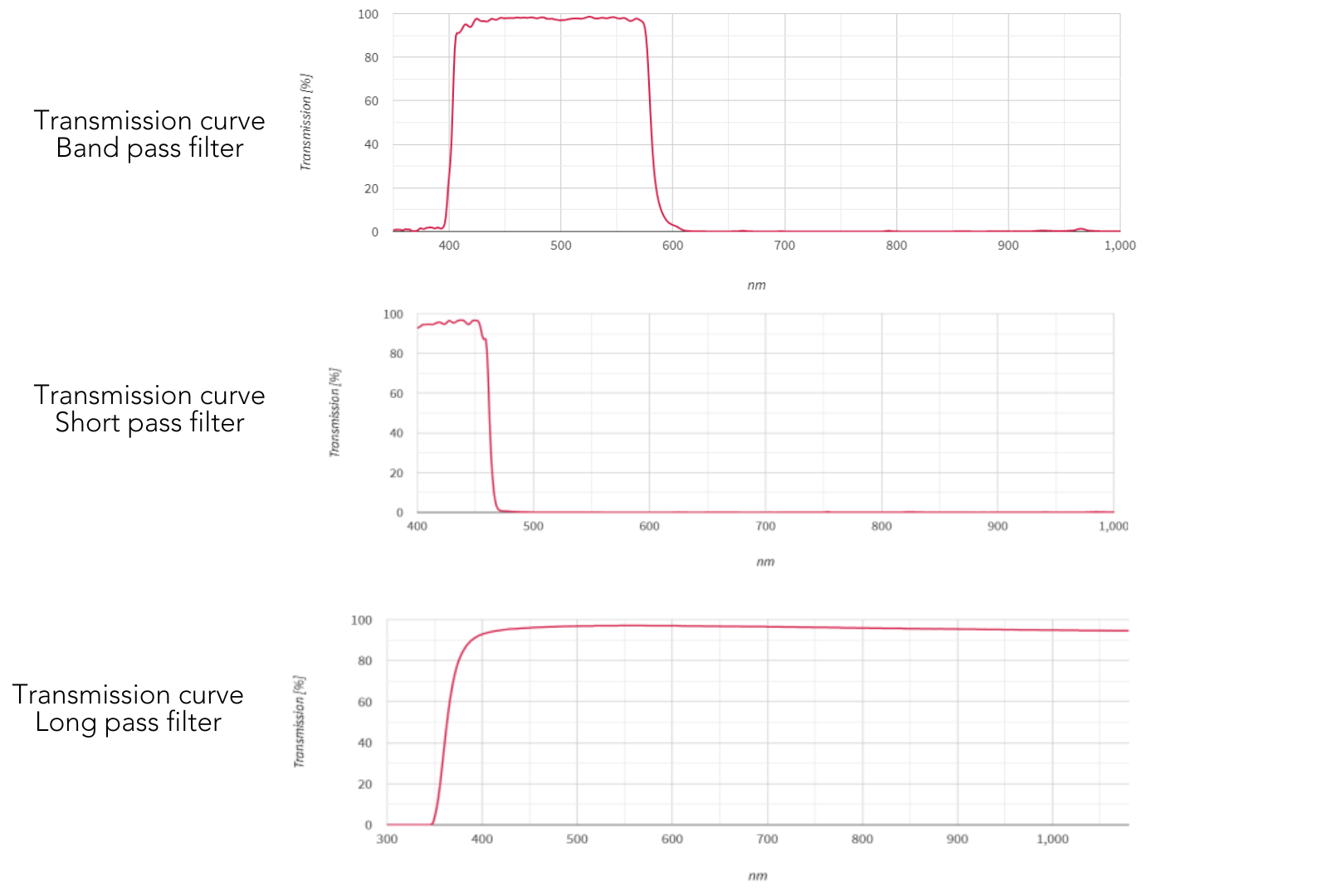 |
Short pass filters allow only wavelengths below a certain cut-off wavelength to pass, while long pass filters allow wavelengths above a defined cut-off wavelength to pass. These filters are used when only certain wavelength ranges are relevant for optical inspection or measurement. For example, in the case of monochromatic illumination from an LED or laser, a narrow bandpass filter blocks out extraneous light, allowing only the illumination itself to pass. In this way, the test or measurement result is not distorted by ambient light. When inspecting coloured objects, the filters can be used to enhance or suppress individual colours, making it easier to see inspection features such as the marking on a package. Applications for these filters are diverse, ranging from spectroscopy, bioanalysis and medicine to traffic monitoring, security technology, 3D measurement and food inspection. |
-
-
Do you have any questions or comments? Then please contact us. We will get back to you as soon as possible. To help us process your request, please fill out all fields marked with *.
HEADQUARTERS - Europe
Jos. Schneider Optische Werke GmbH
Ringstraße 132
55543 Bad Kreuznach | Germany
+49 (0) 671 601 0
BUSINESS UNITS
Business Unit Industry
+49 (0) 671 601 205
isales@schneiderkreuznach.com
Business Unit Photo/ Cine
+49 (0) 671 601 551
B+W belongs to the Photo division
photo@schneiderkreuznach.com
cine@schneiderkreuznach.com
OFFICES WORLDWIDE
America
+1 800 645 7239 (East Coast)
+1 800 228 1254 (West Coast)
Asia
+86 755 8832 1170
Singapore
+65 9488 0062
Exhibitions & Events
Visit us at any tradeshow or event we attend worldwide! Come with your challenge and let our experts help you find the perfect solution for your apllication.

